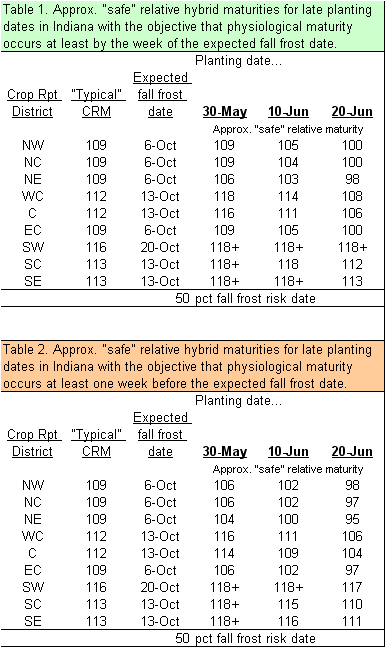Updated 26 May 2011
URL: http://www.kingcorn.org/news/articles.11/SafeHybridMaturities-0517.html

The Crop Reporting Districts are those defined by the National Ag.
Statistics Service, USDA, for Indiana.
The acronym “CRM” refers to
Comparative Relative Maturity as defined by Pioneer Hi-Bred.
Update:
"Safe" Hybrid Maturities for Delayed Corn Planting in Indiana
R.L. (Bob) Nielsen
Agronomy Dept., Purdue Univ.
West Lafayette, IN 47907-2054
Email address: rnielsen
at purdue.edu
The 2011 planting season continues to drag on slowly across Indiana with only 49% of the state's corn acres estimated to have been planted by May 22 (USDA-NASS, 22 May 2011). One of the biggest agronomic concerns with severely delayed planting is the risk of the crop not reaching physiological maturity before a killing fall freeze and the yield losses that could result. An economic concern with delayed planting is the risk of high grain moistures at harvest and the resulting costs incurred by drying the grain or price discounts by buyers.
The tables that accompany this article list "safe" relative hybrid maturities for corn planted from May 30 to June 20 based on their heat unit requirements (adjusted for planting date) and anticipated "normal" accumulation of heat units between planting and an average date (50% probability) of a killing fall freeze. Because GDD accumulations are generally less and "usual" fall frosts occur earlier in the northern and eastcentral areas of Indiana, delayed planting forces hybrid maturity changes earlier than other areas of the state. However, even for those areas of Indiana, serious departures from "typical" hybrid maturities need not be considered until later in May.
The maturities listed in Table 1 are those that should reach physiological maturity at least by the week when a killing fall freeze occurs, while Table 2 lists hybrid maturities that should mature at least one week PRIOR to a killing fall freeze. When making a decision to plant hybrid maturities that are unusually early for your area of the state, make the effort to identify hybrids with good disease resistance traits.
Recognize that while the hybrid maturities listed in either table should safely mature by their respective dates, severely delayed plantings will likely mature at a later time in the fall when further grain drying in the field typically occurs at a proverbial snail's pace. Thus, grain moisture at harvest for delayed plantings may be unacceptably high in terms of both the ease of harvest and the costs of artificially drying the grain.
Farmers can mitigate this aggravation somewhat by planting even earlier maturity hybrids, but recognize that there may not be as great of a difference in grain moisture content as you think. Typically, a one "day" difference in relative maturity rating equals 0.5 percentage point difference in grain moisture content at harvest (Nielsen, 2009). That means there will only be about 2 points difference between, say, a 106-day hybrid and a 110-day hybrid at harvest.
The potential dollar gain from switching from corn to soybean as planting is further delayed is obviously an important consideration for farmers, but one that is difficult to estimate because of the many and varied agronomic and economic assumptions that influence that calculation. Among the challenging assumptions is the expected yield from delayed planting of the corn crop (Nielsen, 2011).
However, if you believe you have good economic estimates to plug into the calculations, then consider an Excel® spreadsheet tool available from the University of Illinois (Schnitkey & Batts, 2011) that will estimate the dollar gain or loss by switching from corn to soybean as planting delayed. This handy Excel spreadsheet offers some assistance in making an economic decision whether to switch from corn to soybean with delayed planting. However, recognize that your choice of yield, grain price, and production costs are critically important to whether the predicted economic results will be close to accurate. My advice: Do not simply use the spreadsheet's default values, but thoughtfully input your own values. Also, recognize you are limited to selecting geographic areas only within Illinois, so non-Illini farmers should exercise caution with the use of this tool.
Related References
Nielsen, Bob. 2002 (rev). Estimating Yield and Dollar Returns From Corn Replanting. Purdue Univ. Cooperative Extension Service publication AY-264-W. Online at http://www.agry.purdue.edu/ext/pubs/AY-264-W.pdf. [URL accessed Apr 2011].
Nielsen, R.L. (Bob). 2009. Interpreting Corn Hybrid Maturity Ratings. Corny News Network, Purdue Univ. [online] http://www.kingcorn.org/news/timeless/HybridMaturity.html [URL accessed Apr 2011].
Nielsen, R.L. (Bob). 2011. Planting Date is Important, But... Corny News Network, Purdue Univ. [online] http://www.kingcorn.org/news/timeless/PltDateCornYld.html [URL accessed May 2011].
Nielsen, R.L. (Bob) and Peter Thomison. 2003. Delayed Planting & Hybrid Maturity Decisions. Purdue Univ. Cooperative Extension Publication AY-312-W. [On-line]. Available at http://www.agry.purdue.edu/ext/pubs/AY-312-W.pdf [URL accessed Apr 2011].
Nielsen, Robert L., Peter R. Thomison, Gregory A. Brown, Anthony L. Halter, Jason Wells, and Kirby L. Wuethrich. 2002. Delayed Planting Effects on Flowering and Grain Maturation of Dent Corn. Agron. J. 94:549-558.
Schnitkey, Gary and Ryan Batts. 2011. Planting Delays and Switching to Soybeans: A New FAST Spreadsheet. Univ. of Illinois Extension. [online] http://farmdoc.illinois.edu/manage/newsletters/fefo11_08/fefo11_08.html. [URL accessed May 2011].

